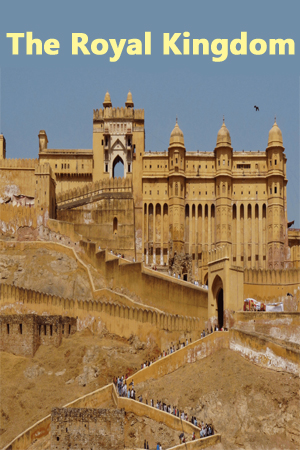The Royal Kingdom
The Royal Kingdom


The train chugged off from Borivali station in Mumbai for Jaipur later than its scheduled time that afternoon. Filled with excitement, I waited for the journey to yet another destination, Mewad in Rajasthan. Loaded with talks about how I had managed to pack the most in the least possible time, my aunts narrated their versions to my mom, while the men got busy verifying the route of our journey.
I have always preferred travelling in a group to enjoy together & of course create umpteen memories to cherish.
‘Did you get enough woollens? The temperature drops to four degrees during the night.’
‘I have carried my DSLR to capture the sunset at Mount Abu.’
‘I can’t wait to shop at Jaipur.’
The constant banter kept us awake the entire afternoon. The windows brightened with the vibrant colour of the evening sky.
The bunk beds in the train were the best part to fight for, have fun together & chat all night. I took the middle berth while my cousins were on the top berth & we spent the night catching up on all the gossips that we could.
The train reached Jaipur station the next morning. A bus waited outside the station to transfer us to our hotel. We were three cousins in all & had to fight to get a room to ourselves while the elders sorted themselves into their rooms. Refreshed, we were at the lunch table, where authentic Rajasthani thali awaited us. We ate Dal-Bhati-Churma (Pulses or Lentils with hard wheat bread rolls to go with Churma which is coarsely ground wheat into pancakes coated in home-made butter), Moong Dal Halwa (an Indian dessert made out of skinless split green gram made in home-made butter & sugar). Each of them was a treat for us.
The next morning, we were at Hawa Mahal (Palace of the Winds), the famous monument of Jaipur stood with pride in bright red sandstone on the edge of the City Palace. This historical palace, built on the lines of a honeycomb of a beehive, with as many as 953 small windows decorated with intricate work, allows cool air for the breeze to pass through, thus making the area more pleasant especially during the high temperatures, being situated in a desert region. The street opposite this royal palace looked lively & inviting with hawkers, who sold a variety of colourful footwear, bangles & other accessories.
‘What kind of life it must’ve been then, when people bustled in Hawa Mahal?’
‘How I wish I could experience life in one such palace!’
‘Hello, dream girl, let’s go check the bangles, they look so lovely.’
We spent the day visiting the City Palace of Jaipur, which was the seat of Maharaja of Jaipur. The palace complex lies in the heart of Jaipur & incorporates an impressive & vast array of courtyards, gardens & buildings. Birla Mandir (Temple) & the City Palace Museum were the next on our agenda. The sun was setting & had cast its glow on these monuments making them shine in gold.
On our way back to the hotel, I shopped on the streets of Jaipur to my heart’s content & bought a variety of bangles, silver earrings, saris & quilts.
My cousin suggested a ride on the cycle-rickshaw. I felt like a queen being driven enjoying the brightly lit streets! We were shivering by the time we reached the hotel, but it felt nice to be away from the hot & humid weather of Mumbai.
We headed for Udaipur the next day. Little did I knew, that I was going to be under a magical spell of actually entering the royal era.
We had hired a guide for that day as every place that we visited seemed to tell a story of its own. We were at Saheliyon ki Baadi (Courtyards of the Maidens), a series of lush green gardens with a variety of fountains sprinkling water all over the place. Lush green gardens in a desert? Wow! I tried to imagine greenery in a desert without much success, eagerly waiting to experience the magic.
A series of lush green gardens spread its vast expanse with a variety of fountains laid in intricate carvings in the bed of greens. I tried to capture the picturesque beauty around me in my DSLR.
‘We are at Saheliyon ki Baadi, magnificent gardens where the princess & her friends played. The guide said that Maharana Sangram Singh had built this garden. His daughter happened to watch the rains for the first time. She loved them so much that she asked her father to get some more of them. Adamant about her demand, the princess went into a depression. Where would the King get the rains in a desert? He assigned the task of ‘creating’ the rains to an artisan in his court. The clever artisan worked on the task for several months. One fine day, he called the King to have a look at his creation. The artisan had actually created a variety of rains from a downpour with thundering to a drizzle to heavy rains, all in the form of a garden with beautiful fountains that flowed from decorated marble elephants with intricate carvings. The artisan had made use of water from a lake that was situated at a height. The fountains gave the appearance of rain water cascading down in a rush. The princess danced with joy in the rains.
With every whistle blown by our Guide, a fountain sprang to life & sprinkled waters. One after the other, the fountains were made alive & started to cast their magic. The surroundings reverberated in the platter of raindrops & the drizzle increased to a heavy downpour with thundering. Spellbound,
I walked as though I were Maharana Sangram Singh’s princess! It felt so magical!
My cousins along with me clicked pictures dressed in the authentic Rajasthani attire in a colourful ghagra choli (long skirt & blouse) with a dupatta (stole) complete with accessories. I floated in the seventh heaven.
‘We meet near the bus at 1 pm’, the Guide’s voice brought me to senses & the spell was broken.
That evening, we visited the historical battlefield of Haldighati, where the tales of Maharana Pratap’s valour are still alive with the life-size statues that showcase the events so vividly.
We paid a visit to the famous Rani Padmini Palace in Chittorgarh. Located amidst water bodies, this was the place where Allaudin Khilji was permitted to see the mirror image of the gorgeous beauty, Rani Padmini, the wife of Maharana Rattan Singh. However, Allaudin Khilji with the intention to win over Rani Padmini & destroy Chittor, turned & killed Maharana Rattan Singh, so goes the story. Rani Padmini committed Jauhar (Jauhar was the Hindu custom in which Rajput women committed suicide with their children, to avoid capture and abuse in the face of inescapable military defeat and capture.)
With goose bumps all-over, I listened to the story of the legend, Rani Padmini. What were the women of those times made of?
The next morning, we visited the famous Five Unique Temples of Dilwara, which are known for its unique architectural beauty. The carvings told a story & stood strong in its beauty.
We were at our next destination, Mount Abu, the only hill station in Rajasthan. It is referred to as ‘an oasis in the desert’ as its heights are home to rivers, lakes, waterfalls & evergreen forests.
The temperature had dropped to nine degrees during the day & four in the night. I fought with my cousins to be in the sunlight that brought some warmth in our hotel room. The sunset point at Mount Abu made me forget that I was in a desert region of Rajasthan. The mountains wrapped in a coat of greens & stood tall protecting the area. A sudden chill filled the air as the sun turned red from a clear orange. Several snapshots clicked away capturing the moment. Lost in my thoughts, I realized that it was getting chilly & hurried to wear my sweater.
The sounds of traffic with fast moving people woke me up to reality. Amidst the hustle & bustle of Mumbai, I opened my eyes & looked at the watch. The train had reached Mumbai. Unfortunately, that being the last leg of our trip, it felt strange to return to the common man’s world. The transformation from the royal kingdom to the present times took a while. A colourful vacation was over, with that my journey to the royal kingdom!




























